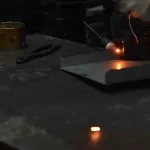Welding finds applications in a wide range of industries, including construction, transportation, agriculture, and professional services. It is an invaluable skill that offers versatility, allowing welders to work in almost any industry.
In this beginner’s guide to welding, we’ll look at:
Welding Town
What welding is
How to get started
The different types of welding
The welding process
Careers in welding
The welding process
The welding process generally follows these steps, regardless of the specific welding method:
- Choose your welding method: Determine the appropriate welding method based on factors such as the material being welded, the environment in which the welding will take place, the desired appearance of the weld, and your budget.
- Get your welding equipment: Ensure you have the necessary welding equipment to perform the job safely and effectively. This includes the welder itself, a welding helmet for eye protection, safety goggles (optional), leather gloves, a leather jacket or welding apron, heat-resistant clothing, and work boots.
- Prepare the weld: Clean the metals to be welded thoroughly, removing any oil, grease, or contaminants. A wire brush and acetone are effective for this purpose. If required, cut the metal to the desired size. Additionally, grind the edges of the metals where the weld will be created, as this helps enhance structural integrity and provides space for the filler material.
- Prepare yourself: Ensure you are equipped with the appropriate safety equipment, including a fire extinguisher. Remember that welding involves working with heat and electricity, so safety is paramount.
- Layer the weld: Begin by tack welding, which involves joining the edges of the metals with short welds. Repeat this process to create subsequent layers until the final weld is achieved. Focus on maintaining a smooth and fluid motion throughout the welding process. Once the welding is complete, allow the weld to cool down.
Tip: To achieve a neater weld, focus on the edge of the melt puddle rather than the arc during the welding process.
- Grind the weld (optional): If desired, you can improve the appearance of the weld by lightly grinding it with a right-angle grinder. This step helps create a smooth finish. However, if appearance is not a concern, you can skip this step. Take care not to exert excessive pressure while grinding, as this may necessitate starting the welding process again.
Following these steps will help ensure a successful welding process, whether you are a beginner or have some experience in welding. Remember to prioritize safety and take the necessary precautions throughout the welding process.
Welding Career Opportunities
Welding presents numerous career opportunities due to its high demand and broad applicability across various industries. It is a skilled trade that offers versatility, challenges, and competitive pay. Welders are essential in numerous sectors, including construction, engineering, agriculture, manufacturing, aerospace, maritime, military, education, business, and sales.
Across the United States, the United Kingdom, and many other countries, there is a significant shortage of skilled welding technicians. This shortage has created a favorable job market for qualified welders. With the right level of skill and experience, welders have abundant opportunities to explore and expand their careers.
In the construction industry, welders contribute to the fabrication and assembly of structures such as buildings, bridges, and pipelines. In engineering, they play a vital role in manufacturing machinery and equipment. Welders are crucial to agricultural operations, ensuring the maintenance and repair of farming machinery. The manufacturing industry heavily relies on welders for producing a wide range of products, from automobiles to consumer goods. In the aerospace sector, welders work on aircraft components and structures. Maritime industries require welders for shipbuilding and repair. Welders are also employed in the military for various applications, including equipment maintenance and repair.
Moreover, the field of education offers opportunities for experienced welders to become instructors, passing on their knowledge and skills to the next generation of welders. Additionally, welders can explore entrepreneurial ventures by starting their own welding businesses or working as freelance welders.
With the shortage of skilled welders and the diverse range of industries that rely on welding, qualified welders have the potential to work both domestically and internationally. Welding skills are highly transferable, opening doors to global job opportunities.
If you possess the necessary skills, experience, and a commitment to continuous learning, the welding field offers a wealth of career prospects and the chance to make a meaningful impact in various industries.












